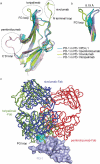Glycosylation-independent binding of monoclonal antibody toripalimab to FG loop of PD-1 for tumor immune checkpoint therapy
- PMID: 30892132
- PMCID: PMC6601540
- DOI: 10.1080/19420862.2019.1596513
Glycosylation-independent binding of monoclonal antibody toripalimab to FG loop of PD-1 for tumor immune checkpoint therapy
Abstract
Monoclonal antibody (mAb)-based blockade of programmed cell death 1 (PD-1) or its ligand to enable antitumor T-cell immunity has been successful in treating multiple tumors. However, the structural basis of the binding mechanisms of the mAbs and PD-1 and the effects of glycosylation of PD-1 on mAb interaction are not well understood. Here, we report the complex structure of PD-1 with toripalimab, a mAb that is approved by China National Medical Products Administration as a second-line treatment for melanoma and is under multiple Phase 1-Phase 3 clinical trials in both China and the US. Our analysis reveals that toripalimab mainly binds to the FG loop of PD-1 with an unconventionally long complementarity-determining region 3 loop of the heavy chain, which is distinct from the known binding epitopes of anti-PD-1 mAbs with structural evidences. The glycan modifications of PD-1 could be observed in three potential N-linked glycosylation sites, while no substantial influences were detected to the binding of toripalimab. These findings benefit our understanding of the binding mechanisms of toripalimab to PD-1 and shed light for future development of biologics targeting PD-1. Atomic coordinates have been deposited in the Protein Data Bank under accession code 6JBT.
Keywords: PD-1; Toripalimab; complex structure; glycosylation.
Figures





Similar articles
-
Toripalimab: the First Domestic Anti-Tumor PD-1 Antibody in China.Front Immunol. 2022 Jan 12;12:730666. doi: 10.3389/fimmu.2021.730666. eCollection 2021. Front Immunol. 2022. PMID: 35095833 Free PMC article. Review.
-
Toripalimab, a therapeutic monoclonal anti-PD-1 antibody with high binding affinity to PD-1 and enhanced potency to activate human T cells.Cancer Immunol Immunother. 2024 Feb 24;73(3):60. doi: 10.1007/s00262-024-03635-3. Cancer Immunol Immunother. 2024. PMID: 38400933 Free PMC article.
-
PD-1 N58-Glycosylation-Dependent Binding of Monoclonal Antibody Cemiplimab for Immune Checkpoint Therapy.Front Immunol. 2022 Mar 2;13:826045. doi: 10.3389/fimmu.2022.826045. eCollection 2022. Front Immunol. 2022. PMID: 35309324 Free PMC article.
-
Identification of a monoclonal antibody that targets PD-1 in a manner requiring PD-1 Asn58 glycosylation.Commun Biol. 2019 Oct 25;2:392. doi: 10.1038/s42003-019-0642-9. eCollection 2019. Commun Biol. 2019. PMID: 31667366 Free PMC article.
-
Toripalimab for the treatment of melanoma.Expert Opin Biol Ther. 2020 Aug;20(8):863-869. doi: 10.1080/14712598.2020.1762561. Epub 2020 May 14. Expert Opin Biol Ther. 2020. PMID: 32406293 Review.
Cited by
-
Toripalimab Plus Chemotherapy for Patients With Treatment-Naive Advanced Non-Small-Cell Lung Cancer: A Multicenter Randomized Phase III Trial (CHOICE-01).J Clin Oncol. 2023 Jan 20;41(3):651-663. doi: 10.1200/JCO.22.00727. Epub 2022 Oct 7. J Clin Oncol. 2023. PMID: 36206498 Free PMC article. Clinical Trial.
-
Long-term survival in extensive-stage small-cell lung cancer treated with different immune checkpoint inhibitors in multiple-line therapies: A case report and literature review.Front Immunol. 2022 Nov 30;13:1059331. doi: 10.3389/fimmu.2022.1059331. eCollection 2022. Front Immunol. 2022. PMID: 36532013 Free PMC article. Review.
-
Advances in the structural characterization of complexes of therapeutic antibodies with PD-1 or PD-L1.MAbs. 2023 Jan-Dec;15(1):2236740. doi: 10.1080/19420862.2023.2236740. MAbs. 2023. PMID: 37530414 Free PMC article. Review.
-
Toripalimab: the First Domestic Anti-Tumor PD-1 Antibody in China.Front Immunol. 2022 Jan 12;12:730666. doi: 10.3389/fimmu.2021.730666. eCollection 2021. Front Immunol. 2022. PMID: 35095833 Free PMC article. Review.
-
Immunotherapy and its racial specificity for breast cancer treatment in Asia: a narrative review.Lancet Reg Health West Pac. 2024 Sep 19;57:101180. doi: 10.1016/j.lanwpc.2024.101180. eCollection 2025 Apr. Lancet Reg Health West Pac. 2024. PMID: 40443538 Free PMC article. Review.
References
-
- Tan S, Gao GF.. New hope for cancer treatment: cancer immunotherapy. Chinese Sci Bull. 2015;60:3155–57. In Chinese.
-
- Nishimura H, Nose M, Hiai H, Minato N and Honjo T. Development of lupus-like autoimmune diseases by disruption of the PD-1 gene encoding an ITIM motif-carrying immunoreceptor. Immunity. 1999;11:141–51. - PubMed
Publication types
MeSH terms
Substances
LinkOut - more resources
Full Text Sources
Other Literature Sources
Medical
